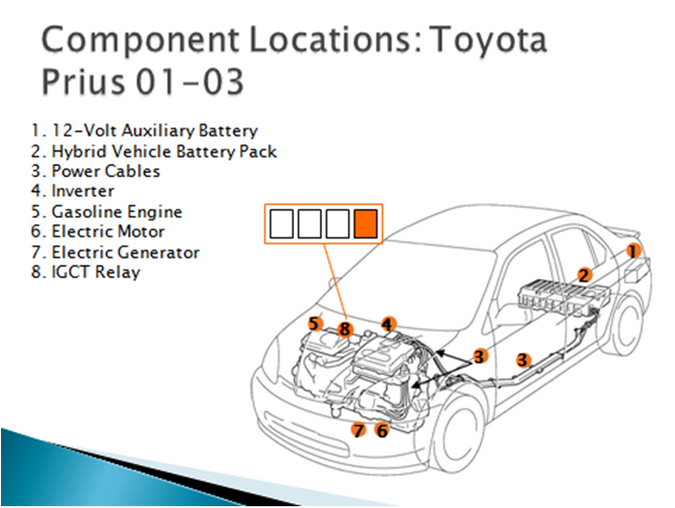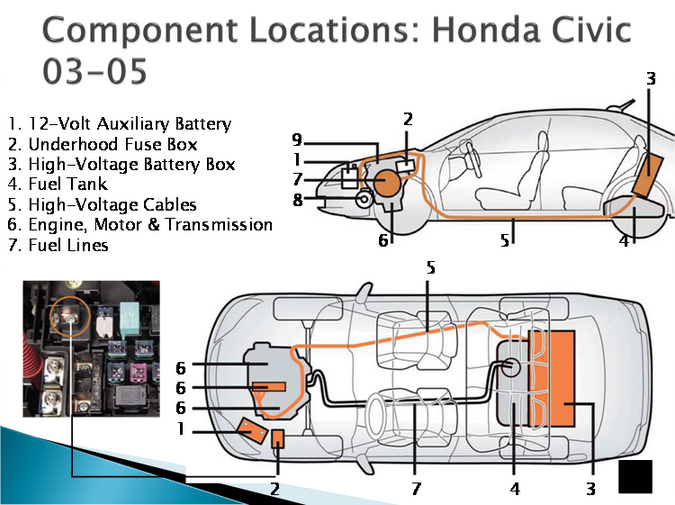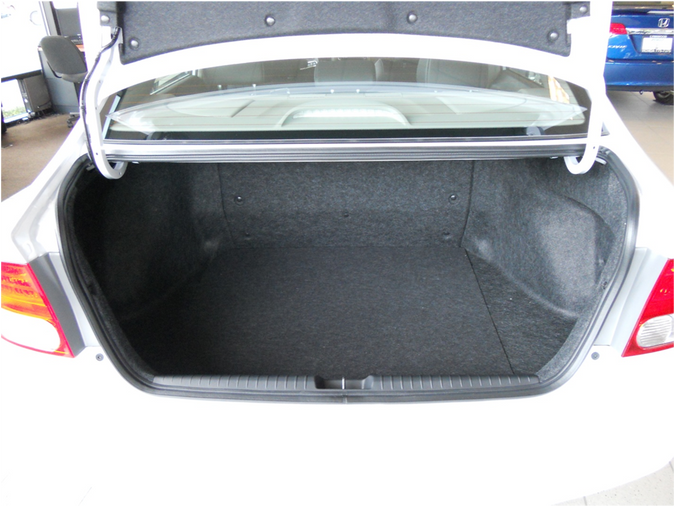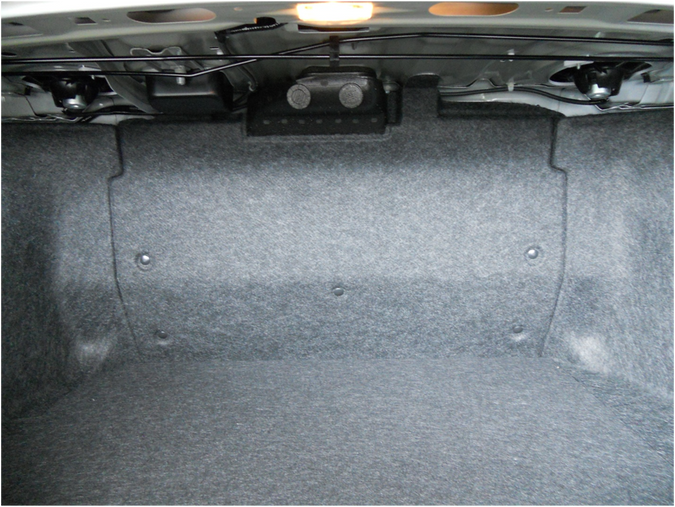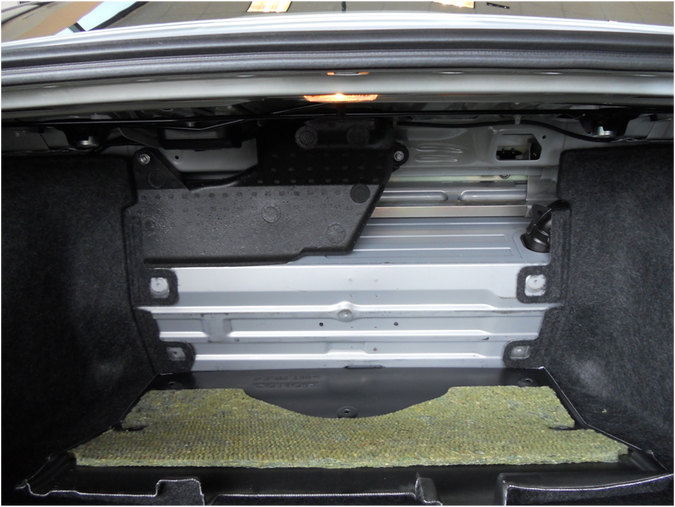
Scenario: MVA
December 6th, 2010
Categories
By Paul Bindon & Matt Stroud
In previous articles, we have focused on the types of technology found in vehicles around us. We can now apply what we know in a real life scenario, see what problems may arise and illustrate possible solutions that may be used.
Keeping in mind that hybrid vehicles have 4 tires and a steering wheel just like all the other vehicles on the road today, the major difference is its propulsion system. Take a conventional vehicle, add a traction motor and high voltage battery, and you basically have a hybrid. This is over simplified to be sure, but makes the point that extrication procedures will differ little between hybrid and conventional vehicles in most cases. Consider the diagram below. Note the position of the high voltage battery, orange high voltage wires and inverter/traction motor. Can you remove the roof of this vehicle for patient access without encountering the high voltage system?
Yes you can. The high voltage components are not located near the pillars supporting the vehicle roof. We can take this a step further and also see that extrication procedures involving door removal, dash displacement and B pillar removal are also not affected by the high voltage components. Since most MVA’s involve vehicle damage that allows patient access with these methods, procedures will not differ in these cases just because the vehicle is a hybrid. Most hybrid vehicle manufacturers place the high voltage battery under the rear seat (SUV) or low in the trunk/cargo area. Some sedans, such as the Honda Civic/Accord Hybrid and the Ford Fusion/Mercury Milan/ Lincoln Mark Z Hybrid, have high voltage components such as the battery behind the seat in a vertical position. This may save cargo space in the trunk by placing these parts up against the back of the passenger seats, but it can also limit access when performing a tunneling operation through the trunk of the vehicle.
All hybrid vehicles have a high voltage battery disconnect (also known as the “orange plug”) of some kind on the high voltage battery. The location of this disconnect will vary by vehicle type. Some are easily accessible like the Ford Escape Hybrid or Toyota Prius which are located in the rear of the vehicle. Others are not as easily found. There are several hybrid models including the Honda Civic Hybrid that place the high voltage battery disconnect on the front side of the battery, located behind the rear passenger seat back. To access the high voltage battery disconnect on these models, the rear seats must be removed. The original purpose of these disconnects was to isolate the high voltage electricity within the battery assembly for maintenance purposes. Little thought seems to have been given to first responder access to these disconnects.
Removing the high voltage disconnect will disable the hybrid system (propulsion only). You may have thought that pulling the orange plug was a complete power down in the past, but this is only part of the necessary procedure. All systems in the vehicle are controlled by the 12V battery including SRS and the HID lighting systems, which will require further action before the vehicle is properly powered down.
SRS systems are controlled by computers that run on 12V. Capacitors in the SRS computer will keep the system operational for a period of time after the 12V battery has been disconnected. These capacitors are designed to allow the system to remain operational if the vehicle’s battery is damaged in a collision, and the vehicle has not yet come to a stop.
The wiring for the SRS system is not integrated into the circuits for the rest of the vehicle. Airbags have their own “+” and “–“ wires that do not use the body of the vehicle as part of the circuit (ground). The electrical power needed to deploy the airbag is supplied by the SRS computer. This computer is supplied with a constant 12V power source from the battery and a switched power source from the ignition circuit. Each of these two power sources must be available for the computer to be operational and be able to deploy an airbag. Auxiliary power sources, such as cell phones, that are connected to the vehicle are therefore unable to power the SRS system and accidently deploy airbags.
HID System Importance
High Intensity Discharge (HID) lighting systems also run on a 12V circuit. These systems use a step up transformer to create an electrical arc within the quartz tube of the headlamp bulb. The operating voltage of this system is approximately 25,000V. This arc heats up the gas within the tube to create a very bright light source. This high voltage/low amperage system does not create a lethal amount of voltage, however the arc is hazardous as an ignition source, and as an electrical shock as well. Vehicles that are damaged in a frontal collision have the potential to arc if you come into close contact with that part of the vehicle.
Now, let’s build a scenario and see how it unfolds.
A Honda Civic Hybrid is travelling on the freeway with 2 adults and 2 kids inside. The driver fails to notice stopped traffic and collides with the rear of a big rig truck. The vehicle is buried under the rear of the trailer up to the C pillar. There is no roof or side door access to the patients inside. They are in need of medical attention, and the heavy wrecker is already responding to another incident and is therefore unavailable.
After your 360 degree evaluation from a safe distance, you have determined that the Honda is on and running. Neither vehicle is on fire and you have found the truck has a load of fluffy soft down pillows. No flammable fluid leaks were found. You have the equipment available for proper vehicle stabilization.
After stabilization of the vehicles, the best approach in this situation to the extrication is to tunnel through the trunk to reach the patients and remove them from the vehicle. After removing the trunk lid and trunk interior trim, you see component #3 in the figure below; the high voltage battery.
The battery pack covers the width of the trunk opening between the wheel wells. There is not enough room to go over, under or around it. Common sense tells you that you must somehow remove the high voltage battery. Conventional training has taught us to avoid touching, cutting or moving the orange high voltage wires. Since this is apparently not possible in this situation, a decision must then be made as to how to deal with the high voltage components of this vehicle. Are you going to follow your previous training and not be able to reach the patients? What other options do you have? Using the knowledge you have, a solution must be found for this situation.
This scenario is set up with enough information to prove a point. The real life aspect of this scenario coupled with the knowledge previously provided should enable you to realize that previous tactics provided by vehicle manufacturers are not an option. The legal ramifications and perfect scenario perspectives of “official” guidelines and recommendations do not apply to the real-life situations often encountered by fire/rescue personnel.
The point of this exercise is to show that there is a solution to the problem. The time for questions is over. What would you do?
